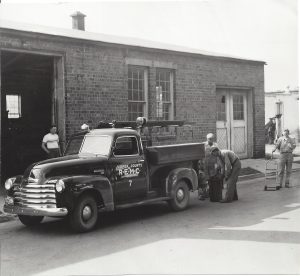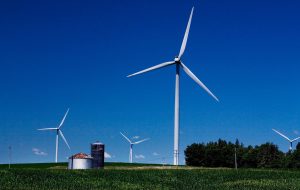We’ve had to learn as we’ve grown. It’s a very complicated business, but our commitment to serve our member co-ops and their communities brings us together and drives us every day.
Jeff Conrad
President & CEO
Wabash Valley Power Alliance
What began as a vision 60 years ago has transformed communities and companies across the Midwest.
Wabash Valley Power Alliance has established a legacy of cooperation — serving as a vested partner in providing reliable, cost-effective power to businesses, residents and communities.

Wabash Valley Power was created by five Indiana electric distribution cooperatives, including Jasper County REMC.
Today, WVPA serves 23 distribution cooperatives and is the 17th largest generation and transmission electric cooperative in the United States, now serving more than 350,000 homes, schools, farms and businesses in Illinois, Indiana and Missouri.
Getting to that point has taken 60 years of developing, evolving and understanding what customers need and how to provide it — responsibly and reliably.
“We’ve had to learn as we’ve grown,” said Jeff Conrad, president and CEO of Wabash Valley Power. “It’s a very complicated business, but our commitment to serve our member co-ops and their communities brings us together and drives us every day.”
It began in 1963, when five distribution cooperatives came together with a focused vision of improving overall buying power within the electricity marketplace. While investor-owned utilities were bringing power to cities, that wasn’t always the case for rural locations. Knowing their collective influence was more powerful, the five co-ops banded together and created a way to gain influence and leverage a little bargaining power.
Together they created a generation and transmission cooperative and established headquarters in Peru, Indiana, along the banks of the Wabash River, which inspired the name Wabash Valley Power Association.

WVPA has developed a decarbonization strategy that balances members’ needs with environmental responsibility, which includes adding zero-emission resources, eliminating carbon in the power supply portfolio and using of edge-of-grid technologies.
The goal was to find ways to collectively share the cost and risk while providing expertise, and that’s exactly what they did; their new organization became more of an extension of these co-ops by building a way for economies of scale to come together and be big enough to compete in their markets.
Ultimately, they created a system of providing low-cost, reliable power to rural America, including its farming and manufacturing operations, and beyond.
Over the years, membership continued to grow as more distribution cooperatives saw the benefits of buying through a larger cooperative and in 1976, the WVPA headquarters relocated to Indianapolis. WVPA attributes that growth and success to its deliberately different approach that includes enhancing the well-being of every family, company, co-op and community served.
“Electricity is an essential service. We all expect the light to come on when we flip the switch,” said Phil Hayes, chairman of WVPA’s board of directors. ”We understand we play a crucial role in providing that service, reliably and responsibly.”
Instead of selling electricity to customers and earning profits for shareholders, WVPA acts a true not-for-profit cooperative organization with one simple mission: to provide affordable and reliable electricity to each member — who are actually owners.

WVPA has developed a diverse power supply portfolio that includes natural gas, coal and renewables, to reduce price volatility.
They are also committed to supporting communities by being a responsible partner in overall economic development.
“One of our key responsibilities is ensuring local and regional economic development teams are able to attract, retain and grow businesses in their territories,” said WVPA Chief Operating Officer Theresa Young. “We exist to support those teams, businesses and communities in any way possible, either providing information, seeking incentives, assisting with training and workforce development. WVPA is an extension of every operation.”
And that has meant evolving with the needs of the industry and its customers.
“Early on it, became obvious we needed to have steel in the ground,” said Fred Powell, former WVPA board chairman. “If we were going to be a generation and transmission, then we needed to provide that.”
That was a significant step in diversifying WVPA’s portfolio, and the first of many steps toward seeking more economical, reliable and responsible ways of providing energy. Over the decades, WVPA sought to make operations more energy efficient and environmentally responsible. In 2008, WVPA helped establish the National Renewables Cooperative Organization (NRCO), which supports companies to navigate the constantly evolving renewable energy processes.

Today, Wabash Valley Power Alliance generates electricity for 23 Midwestern electric distribution cooperatives that collectively serve more than 350,000 families and businesses.
In 2010, WVPA established the Power Moves Program, which incentivizes co-op members for making energy efficiency upgrades within their operations by providing rebates and opportunities for immediate and long-term savings. More than $32 million in incentives have been awarded to more than 50,000 co-op members to date, with $1 million of that provided directly through WVPA’s New Business Construction Program.
In 2019, WVPA moved into its new home, a state-of-the-art building that provided enough room to house everyone, including a new operations center providing 24/7 real-time monitoring of the energy grid, under one roof.
That has meant a concerted focus on expanding capabilities and transitioning from fossil fuels to renewables.
As WVPA continues looking toward the future, the focus remains on powering an industry toward more responsible and reliable energy and achieving net zero carbon emissions. WVPA has developed a decarbonization strategy that balances members’ needs for reliable and affordable electricity with environmental responsibility, which includes adding zero-emission resources, eliminating carbon in the power supply portfolio and using of edge-of-grid technologies. That strategy puts WVPA on track to reduce carbon emissions by 50% in 2031 and achieve net zero by 2050.
“Newer technology has led to innovative opportunities to incorporate more energy resources, including renewable resources, into our power supply portfolio,” Conrad said. “We will continue to develop a flexible power supply that reduces price volatility while taking advantage of unique opportunities that help us plan for the future responsibly.”

